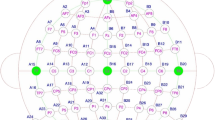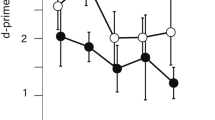Abstract
Recent studies have demonstrated that dyslexia is associated with deficits in the temporal encoding of sensory information. While most previous studies have focused on information processing within a single sensory modality, it is clear that the deficits seen in dyslexia span multiple sensory systems. Surprisingly, although the development of linguistic proficiency involves the rapid and accurate integration of auditory and visual cues, the capacity of dyslexic individuals to integrate information between the different senses has not been systematically examined. To test this, we studied the effects of task-irrelevant auditory information on the performance of a visual temporal-order-judgment (TOJ) task. Dyslexic subjects’ performance differed significantly from that of control subjects, specifically in that they integrated the auditory and visual information over longer temporal intervals. Such a result suggests an extended temporal “window” for binding visual and auditory cues in dyslexic individuals. The potential deleterious effects of this finding for rapid multisensory processes such as reading are discussed.





Similar content being viewed by others
References
Bertelson P, Radeau M (1981) Cross-modal bias and perceptual fusion with auditory-visual spatial discordance. Percept Psychophys 29:578–584
Biscaldi M, Fischer B, Hartnegg K (2000) Voluntary saccadic control in dyslexia. Perception 29:509–521
Brannan JR, Williams MC (1988) Developmental versus sensory deficit effects on perceptual processing in the reading disabled. Percept Psychophys 44:437–444
Denckla M, Rudel RG (1976) Rapid automatized naming (RAN): dyslexia differentiated from other learning disabilities 89. Neuropsychologia 14:471–479
Fischer B, Hartnegg K (2004) On the development of low-level auditory discrimination and deficits in dyslexia. Dyslexia 10:105–118
Fischer B, Hartnegg K, Mokler A (2000) Dynamic visual perception of dyslexic children. Perception 29:523–530
Flowers DL (1993) Brain basis for dyslexia: a summary of work in progress. J Learn Disabil 26:575–582
Flowers DL (1995) Neuropsychological profiles of persistent reading disability and reading improvement. In: Joshi RM (ed) Developmental and acquired dyslexia. Kluwer Academic Publishers, Netherlands, pp 61–77
Flowers DL, Wood FB, Naylor CE (1991) Regional cerebral blood flow correlates of language processes in reading disability. Arch Neurol 48:637–643
Habib M (2000) The neurological basis of developmental dyslexia: an overview and working hypothesis. Brain 123(Pt 12):2373–2399
Hairston WD, Laurienti PJ, Mishra G, Burdette JH, Wallace MT (2003) Multisensory enhancement of localization under conditions of induced myopia. Exp Brain Res 152:404–408
Hook P, Macaruso P, Jones S (2001) Efficacy of FastForward training on fascilitating acquisition of reading skills by children with reading difficulties—a longitudinal study. Ann Dyslexia 51:75–97
Joshi RM, Dahlgren M, Boulware-Gooden R (2002) Teaching reading in an inner city school through a multisensory teaching approach. Ann Dyslexia 52:229–242
Kinsbourne M, Rufo DT, Gamzu E, Palmer RL, Berliner AK (1991) Neuropsychological deficits in adults with dyslexia. Dev Med Child Neurol 33:763–775
Laasonen M, Tomma-Halme J, Lahti-Nuuttila P, Service E, Virsu V (2000) Rate of information segregation in developmentally dyslexic children. Brain Lang 75:66–81
Laasonen M, Service E, Virsu V (2001) Temporal order and processing acuity of visual, auditory, and tactile perception in developmentally dyslexic young adults. Cogn Affect Behav Neurosci 1:394–410
Laasonen M, Lahti-Nuuttila P, Virsu V (2002a) Developmentally impaired processing speed decreases more than normally with age. Neuroreport 13:1111–1113
Laasonen M, Service E, Virsu V (2002b) Crossmodal temporal order and processing acuity in developmentally dyslexic young adults. Brain Lang 80:340–354
Lindamood CH, Lindamood PC (1979) Lindamood auditory conceptualization test. Teaching Resources Corporation, Boston, Mass., USA
Massaro DW, Cohen MM, Smeele PM (1996) Perception of asynchronous and conflicting visual and auditory speech. J Acoust Soc Am 100:1777–1786
Meredith MA, Nemitz JW, Stein BE (1987) Determinants of multisensory integration in superior colliculus neurons I Temporal factors. J Neurosci 7:3215–3229
Morein-Zamir S, Soto-Faraco S, Kingstone A (2003) Auditory capture of vision: examining temporal ventriloquism. Brain Res Cogn Brain Res 17:154–163
Oakland T, Black JL, Stanford G, Nussbaum NL, Balise RR (1998) An evaluation of the dyslexia training program: a multisensory method for promoting reading in students with reading disabilities. J Learn Disabil 31:140–148
Overy K (2003) Dyslexia and music. From timing deficits to musical intervention. Ann N Y Acad Sci 999:497–505
Pennington BF, Gilger JW, Pauls D, Smith SA, Smith SD, DeFries JC (1991) Evidence for major gene transmission of developmental dyslexia. JAMA 266:1527–1534
Ramus F (2001) Dyslexia Talk of two theories. Nature 412:393–395
Ramus F (2003) Developmental dyslexia: specific phonological deficit or general sensorimotor dysfunction?. Curr Opin Neurobiol 13:212–218
Reed MA (1989) Speech perception and the discrimination of brief auditory cues in reading disabled children. J Exp Child Psychol 48:270–292
Richardson E, DiBenedetto B (1985) Decoding skills test. York Press, Parkton, Md., USA
Rosner J (1979) Helping children overcome learning difficulties. Walker, N.Y., USA
Shaywitz SE (1998) Dyslexia. N Engl J Med 338:307–312
Shaywitz SE, Shaywitz BA, Pugh KR, Fulbright RK, Constable RT, Mencl WE, Shankweiler DP, Liberman AM, Skudlarski P, Fletcher JM, Katz L, Marchione KE, Lacadie C, Gatenby C, Gore JC (1998) Functional disruption in the organization of the brain for reading in dyslexia. Proc Natl Acad Sci USA 95:2636–2641
Slutsky DA, Recanzone GH (2001) Temporal and spatial dependency of the ventriloquism effect. Neuroreport 12:7–10
Stein J (2001) The magnocellular theory of developmental dyslexia. Dyslexia 7:12–36
Stein BE, Meredith MA (1993) The merging of the senses. MIT Press, Cambridge, Mass., USA
Stein J, Walsh V (1997) To see but not to read; the magnocellular theory of dyslexia. Trends Neurosci 20:147–152
Tallal P (1980) Auditory temporal perception, phonics, and reading disabilities in children. Brain Lang 9:182–198
Tallal P, Miller S, Fitch RH (1993) Neurobiological basis of speech: a case for the preeminence of temporal processing. Ann N Y Acad Sci 682:27–47
Wagner RK (1986) Phonological processing abilities and reading: implications for disabled readers. J Learn Disabil 19:623–630
Wechsler D (1999) Wechsler abbreviated scale of intelligence. Psychological Corporation, San Antonio, Tex., USA
Wiederholt JL, Bryant BR (1992) Gray oral reading tests, 3rd edn. PRO-ED Inc, Austin, Tex., USA
Wilkinson GS (1993) The wide range achievement test, 3rd edn. Wide range Inc, Wilmington, Del., USA
Wood FB, Flowers DL (1999) Functional neuroanatomy of dyslexic subtypes: a survey of 43 candidate regions with a factor analytic validation across 100 cases. In: Duane DD (ed) Reading and attention disorders: neurobiological correlates. York Press, Baltimore Md., pp 131–161
Wood FB, Garrett AS, Hart LA, Flowers DL, Absher JR (1996) Event related potential correlates of glucose metabolism in normal adults during a cognitive activation task. In: Krasnegor N (ed) Developmental neuroimaging: mapping the development of brain and behavior. Academic Press, New York, N.Y. USA, pp 197–206
Wood FB, Flowers DL, Grigorenko EL (2001) The functional neuroanatomy of fluency or why walking is just as important to reading as talking is. In: Wolf M (ed) Dyslexia, fluency, and the brain. York Press, Baltimore Md., pp 235–244
Woodcock RW, McGrew KS, Mather N (2001) Woodcock-Johnson Tests of Achievement-III. Riverside Publishing Co., Itasca, Ill., USA
Acknowledgements
The authors would like to thank Debbie Hill for her assistance in arranging subjects, and Dr. Paul Laurienti for his helpful discussion. Funding for this study was provided in part by NIH DC 00057, HD21887, and MH63861.
Author information
Authors and Affiliations
Corresponding author
Rights and permissions
About this article
Cite this article
Hairston, W.D., Burdette, J.H., Flowers, D.L. et al. Altered temporal profile of visual–auditory multisensory interactions in dyslexia. Exp Brain Res 166, 474–480 (2005). https://doi.org/10.1007/s00221-005-2387-6
Received:
Accepted:
Published:
Issue Date:
DOI: https://doi.org/10.1007/s00221-005-2387-6




